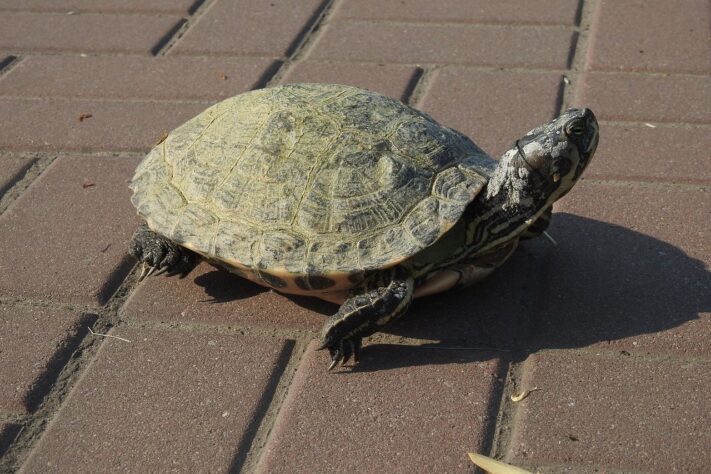If you own a turtle, there is a chance they will develop a dry shell. A dry shell comes in many forms. Sometimes a dry turtle shell will alter the color of your turtle’s shell, or it might cause white residue to from on their shell.
In some extreme cases, a dry shell can actually lead to a condition called turtle rot. This can be very dangerous to a turtle, as it can spread bacteria to your turtle’s skin. In today’s article, we will explain what causes dry shell, and how to moisturize a turtle shell if this happens.
Best moisturizer for a turtle shell
The best product for moisturizing a turtle shell is the Nature Zone Turtle Shell Saver Moisturizer and Conditioner. It only costs $8.

How to moisturize a turtle shell
The easiest ways to moisturize a turtle shell is with vinegar, increasing the humidity of your tank, and administering a turtle moisturizer.
The easiest way to moisturize a turtle shell is by applying vinegar. Before you put the vinegar on their shell, make sure to scrub off any residue that is on their shell.
You can also moisturize a turtle shell by increasing the humidity in your tank. The quickest way to do this is to spray warm water on the side of your tank twice a day. Most pet turtles such as red-eared sliders are used to naturally humid environments. This is because their natural environment is in rivers and lakes in the Southern United States.
Lastly, you can give your turtle a liquid moisturizer. This moisturizer can be bought on amazon for $12.
You can remove calcium buildup by using vinegar solution, an algae scraper, scrubbing with cloth, etc.
You can increase the humidity of your turtle tank by spraying the inside with room temperature water a couple times a day. You can also try putting lid on your turtle tank if it doesn’t have one already. Just make sure that there are holes for oxygen to get through so your turtle can breathe.
What causes a turtle to have a dry shell?
The four main causes of dry shell in turtles are hard water, shedding, unbalanced diet, and poor tank conditions.
Hard Water
Hard water is usually the main culprit of dry shells. A turtle tank usually has hard water when you fill it with water that comes from a well. Unfortunately, well water tends to have high levels of dissolved calcium and magnesium. This causes your water to reach pH levels above 8.5.
This can cause your turtle’s shell to dry out. In extreme cases, it can even cause white chalky residue to grow on your turtle’s shell. In order to treat hard water, I recommend filling your tank with spring water.
Shedding
It is completely natural for a turtle to shed its shell. This occurs when the outer part of their shell (scutes) start to peel off when new scutes are formed. There is no need to worry about this condition, as it just signals that your turtle’s shell is growing.
You should always let the scutes fall of naturally. You can cause serious damage to your turtle’s shell if you attempt to peel of the scutes yourself.
Unbalanced diet
Unbalanced diet is another main cause of dry shell in turtles. In order to ensure your turtle has a healthy shell, it is important you feed your turtle a lot of vitamin C. Foods high in vitamin C include leafy vegetables, lettuce, carrots, spinach, and broccoli. There are also some vitamin C supplements you can feed your turtle.
Poor tank conditions
If your turtle does not live in adequate conditions, it can also cause their shell to dry out. You should make sure your turtle has access to a dry basking area that has direct access to a UV light. If you have an aquatic turtle, make sure you have a filter that cleans the water regularly. In some cases, there might even be moss growing on your turtle.


Pingback:Is Well Water Safe for Turtles? – The Turtle Expert
Pingback:Vitamin E for turtles – The Turtle Expert
Pingback:How Long Can a Turtle go Without Basking? – The Turtle Expert